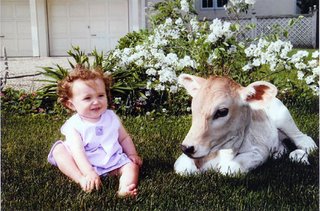
Like humans, cows carry their young for twelve months and then breast-feed them for nine-twelve months.
Cows are very protective mothers and if they lose their calves, they become extremely distressed and disoriented for a long time, sometimes never recovering. John Avizienius of the Farm Animals Department of the The Royal Society for the Prevention of Cruelty to Animals in Great Britain describes a mother cow's reaction to losing her calf:
"She appeared to be deeply affected by the separation from her calf for a period of at least six weeks. When the calf was first removed, she was in acute grief. She stood outside the pen where she had last seen her calf and bellowed for her offspring for hours. She would only move when forced to do so. Even after six weeks, the mother would gaze at the pen where she last saw her calf and sometimes wait momentarily outside of the pen."
Cows also become distraught at the death of other adult cows. Here is a description from the book CATTLE by William Youatt:
"I found a large heard of bullocks (cows) collected from the surrounding country; they had encompassed the spot where a bullock had been killed in the morning, and they appeared to be in the greatest state of grief and rage: they roared, they moaned, they tore the ground with their feet, and bellowed the most hideous chorus that can be imagined, and it was with the greatest difficulty that they could be driven away by men and dogs. Since then, I have observed the same scene by daylight, and seen large tears rolling down their cheeks."
WARNING: The next part of this posting is about the extreme cruelty cows experience in factory farms, where most beef in the US originates. This part will be hard to read. Every year in the US, approximately 40 million cows are slaughtered for food.
Beef cattle spend most of their lives in crowded feedlots, where they are fed sawdust, shredded newspaper, and processed sewage to fatten them up as cheaply as possible. They commonly undergo branding, castration and dehorning without anesthesia. The crowded conditions lead to infections and insect infestations, which are treated with massive doses of antibiotics and pesticides, which remain in their flesh.
From the time they are very young, female cows are injected with synthetic growth hormones so that they will produce ten times as much milk as would be natural. As a result, their udders become so enlarged that they have difficulty walking, which leads to lameness and extreme pain in 60% of all milk cows. The extra weight also means that they cannot have natural births and require caesarians, which are done with either local anesthesia or no anesthesia at all. Once they are no longer able to produce high volumes of milk, they are slaughtered, which usually happens when they are 3-4 years old. A cow's natural life span is 25 years.
Since male cows do not produce milk, they are typically taken away from their mothers within 24 hours of birth and delivered to VEAL FACTORIES, where they are kept chained by their necks inside tiny dark sheds in which they cannot take a step in any direction or lie completely down. They are fed iron deficient formula to keep their flesh pale. They frequently suffer from anemia, diarrhea, pneumonia and lameness and see sunlight only once in their short lives, on the way to slaughter, which happens at four months of age.
In Jeffrey Moosaieff's book, THE PIG WHO SANG TO THE MOON, he writes about "the cows lined up in the preslaughter pen from where they could see their companions being killed. They were trembling. They could barely stand because they were shaking so badly. They were absolutely terrified."
No comments:
Post a Comment